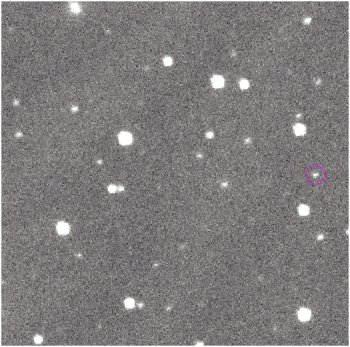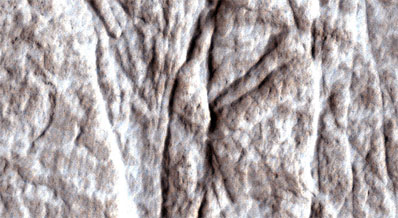 Uma das imagens da descoberta do asteróide 2008 TC3 (circulo violeta). Crédito: Richard Kowalski e Ed Beshore, Catalina Sky Survey.
Uma das imagens da descoberta do asteróide 2008 TC3 (circulo violeta). Crédito: Richard Kowalski e Ed Beshore, Catalina Sky Survey. Há poucos dias, no quadro de um projecto da
NASA National Aeronautics and Space Administration (NASA)
Entidade norte-americana, fundada em 1958, que gere e executa os programas espaciais dos Estados Unidos da América.
para a vigilância da vizinhança do nosso
planeta planeta
Um planeta é um objecto que se forma no disco que circunda uma estrela em formação e cuja massa é superior à de Plutão (1/500 da massa da Terra) e inferior a 10 vezes a massa de Júpiter. Ao contrário das estrelas, os planetas não produzem luz, apenas reflectem a luz da estrela que orbitam.
, foi descoberto no espaço, próximo da Terra, um pequeno
asteróide asteróide
Um asteróide é um pequeno corpo rochoso que orbita em torno do Sol, com uma dimensão que pode ir desde os 100 m até aos 1000 km. A maioria dos asteróides encontra-se entre as órbitas de Marte e de Júpiter. Também são designados por planetas menores.
(de poucos metros de diâmetro). Após várias observações, tornou-se claro que esta pedra do espaço se dirigia mesmo para nós. A notícia não provocou qualquer alarme, já que as dimensões deste objecto não permitiriam que atravessasse a
atmosfera atmosfera
1- Camada gasosa que envolva um planeta ou uma estrela. No caso das estrelas, entende-se por atmosfera as suas camadas mais exteriores. 2- A atmosfera (atm) é uma unidade de pressão equivalente a 101 325 Pa.
intacto. Refinados os cálculos, foi determinado que a entrada no invólucro gasoso que nos protege seria feita sobre a África, numa trajectória para leste, na madrugada passada, e que em poucos segundos o asteróide se transformaria numa bola de fogo (numa descrição simplista), oferecendo um magnífico espectáculo a quem estivesse na região. Dados os problemas existentes na área, e o nível de desenvolvimento tecnológico das populações locais, é pouco provável que nos cheguem relatos do solo. No entanto, à hora prevista, a tripulação de um avião da KLM avistou, a uma considerável distância, o fenómeno luminoso previsto. Foi a primeira vez que se previu o encontro entre o nosso planeta e um objecto menor do
Sistema Solar Sistema Solar
O Sistema Solar é constituído pelo Sol e por todos os objectos que lhe estão gravitacionalmente ligados: planetas e suas luas, asteróides, cometas, material interplanetário.
. É verdade que existem objectos de muito maiores dimensões a vogar pelo espaço e a cruzar a
órbita órbita
A órbita de um corpo em movimento é a trajectória que o corpo percorre no espaço.
que a Terra descreve em torno do
Sol Sol
O Sol é a estrela nossa vizinha, que se encontra no centro do Sistema Solar. Trata-se de uma estrela anã adulta (dita da sequência principal) de classe espectral G. A temperatura na sua superfície é aproximadamente 5800 graus centígrados e o seu raio atinge os 700 mil quilómetros.
, mas não vale a pena ficar assustado: as probabilidades de um encontro são infinitesimais, e este caso demonstra que já existe um esforço para localizar os objectos potencialmente perigosos – o primeiro passo para, em caso de necessidade, intervir e desviá-los do nosso planeta. Que, no passado, já sofreu impactos de vastas consequências, nomeadamente para a biosfera.
O que sucedeu a este pequeno asteróide – baptizado 2008 TC3 – pode ser resumido numa explosão com o poder equivalente a mil
toneladas tonelada (t)
A tonelada (t) é uma unidade de massa equivalente a 1000 kg.
de TNT, que iluminou o céu em redor como se fosse a
Lua Lua
A Lua é o único satélite natural da Terra.
cheia e produziu um magnífico espectáculo visual. Este destino ilustra bem o que se passa num planeta como o nosso, cuja superfície está protegida deste tipo de objectos por uma atmosfera relativamente densa. Apesar de existirem diversos factores a ditarem o destino de um objecto que a penetra – as dimensões, claro, mas também a velocidade relativa, o ângulo de entrada e as propriedades físicas do objecto – a atmosfera cobra um elevado preço pela passagem. Todos já observaram uma "
estrela estrela
Uma estrela é um objecto celeste gasoso que gera energia no seu núcleo através de reacções de fusão nuclear. Para que tal possa suceder, é necessário que o objecto possua uma massa superior a 8% da massa do Sol. Existem vários tipos de estrelas, de acordo com as suas temperaturas efectivas, cores, idades e composição química.
cadente": não passa geralmente de uma partícula de muito pequenas dimensões que depressa é consumida pelo atrito na descida pela atmosfera. Quando se trata de objectos de maiores dimensões, uma analogia simples pode ajudar a perceber os acontecimentos: numa série televisiva que passa num canal de cabo, os "Caçadores de Mitos" experimentaram disparar armas de fogo contra a água, numa piscina. Quando utilizaram uma arma que imprimia grande velocidade ao projéctil, não o encontraram no fundo da piscina: ao penetrar na água, um meio muito mais resistente do que o ar, o projéctil tinha sido despedaçado. Imaginemos agora o que acontece a um asteróide que viaja pelo espaço, sem resistência, e entra numa atmosfera… A pressão, para lá de aquecer a frente do objecto, leva facilmente à sua destruição completa. Muitas vezes tudo o que chega ao solo são pequenos
meteoritos meteorito
Um meteorito é um corpo sólido que entra na atmosfera da Terra (ou de outro planeta), sendo suficientemente grande para não ser totalmente destruído pela fricção com as partículas da atmosfera, e assim atingir o solo. Os meteoritos dividem-se em três categorias, segundo a sua composição: aerolitos (rochosos), sideritos (ferro) e siderolitos (ferro e rochas).
, já sem a velocidade que traziam do espaço, o que explica que nem sequer cheguem a produzir crateras. Outras vezes, todo o objecto explode em altitude, embora possam sobreviver fragmentos importantes (como se pensa agora que sucedeu em Tunguska, em 1908). Claro que nem sempre isto se passa assim (veja-se o caso do Peru, no ano passado). E depois, há que contar com aqueles objectos de maiores dimensões, que fazem da atmosfera pouco mais do que uma película facilmente ultrapassável… como os dinossauros e muitos outros tipos de animais descobriram, há 65 milhões de anos atrás. Para isso, existem projectos, não apenas de vigilância sideral, mas mesmo de visita a asteróides por missões automáticas, de forma a compreender melhor a sua estrutura e as possibilidades de agir (destruir ou desviar) sobre objectos de dimensões e
massas massa
A massa é uma medida da quantidade de matéria de um dado corpo.
importantes.











 O cientista japonês Makoto Kobayashi concede entrevista após saber que venceu o Nobel
O cientista japonês Makoto Kobayashi concede entrevista após saber que venceu o Nobel













